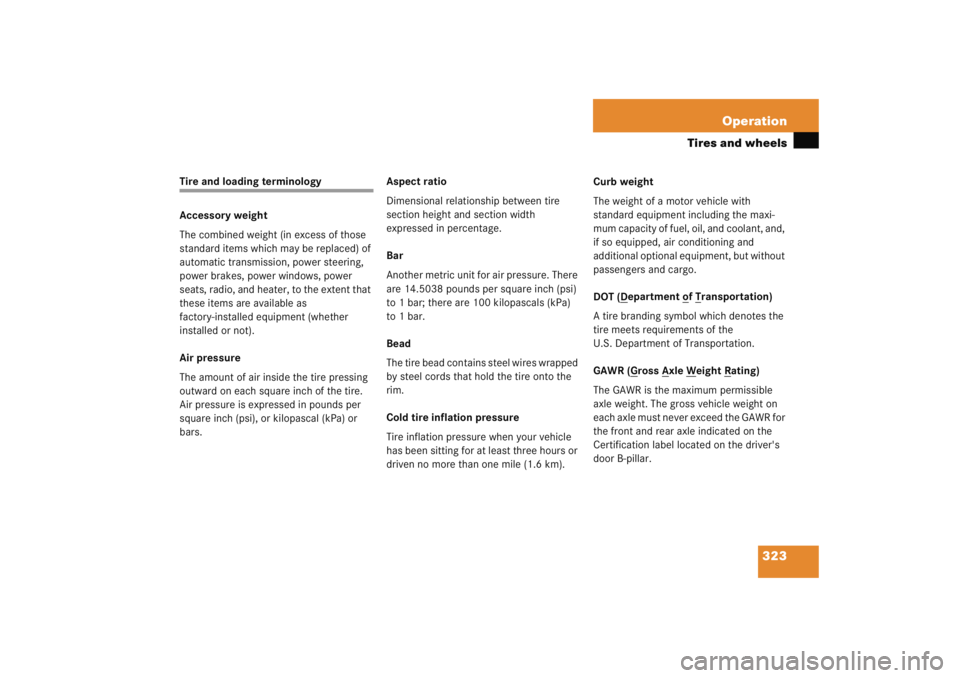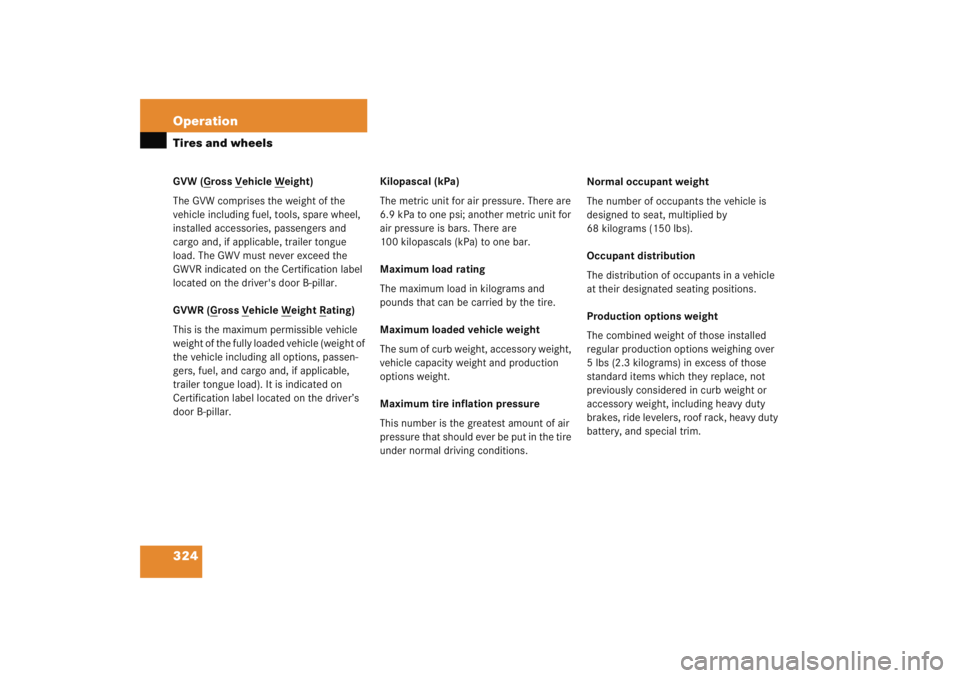Page 324 of 474

323
Operation
Tires and wheels
Tire and loading terminology
Accessory weight
The combined weight (in excess of those
standard items which may be replaced) of
automatic transmission, power steering,
power brakes, power windows, power
seats, radio, and heater, to the extent that
these items are available as
factory-installed equipment (whether
installed or not).
Air pressure
The amount of air inside the tire pressing
outward on each square inch of the tire.
Air pressure is expressed in pounds per
square inch (psi), or kilopascal (kPa) or
bars.
Aspect ratio
Dimensional relationship between tire
section height and section width
expressed in percentage.
Bar
Another metric unit for air pressure. There
are 14.5038 pounds per square inch (psi)
to 1 bar; there are 100 kilopascals (kPa)
to 1 bar.
Bead
The tire bead contains steel wires wrapped
by steel cords that hold the tire onto the
rim.
Cold tire inflation pressure
Tire inflation pressure when your vehicle
has been sitting for at least three hours or
driven no more than one mile (1.6 km). Curb weight
The weight of a motor vehicle with
standard equipment including the maxi-
mum capacity of fuel, oil, and coolant, and,
if so equipped, air conditioning and
additional optional equi
pment, but without
passengers and cargo.
DOT (D
epartment o
f T
ransportation)
A tire branding symbol which denotes the
tire meets requirements of the
U.S. Department of Transportation.
GAWR (G
ross A
xle W
eight R
ating)
The GAWR is the maximum permissible
axle weight. The gross vehicle weight on
each axle must never exceed the GAWR for
the front and rear axle indicated on the
Certification label located on the driver's
door B-pillar.
Page 325 of 474

324 OperationTires and wheelsGVW (G
ross V
ehicle W
eight)
The GVW comprises the weight of the
vehicle including fuel, tools, spare wheel,
installed accessories, passengers and
cargo and, if applicable, trailer tongue
load. The GWV must never exceed the
GWVR indicated on the Certification label
located on the driver's door B-pillar.
GVWR (G
ross V
ehicle W
eight R
ating)
This is the maximum permissible vehicle
weight of the fully loaded vehicle (weight of
the vehicle including all options, passen-
gers, fuel, and cargo and, if applicable,
trailer tongue load). It is indicated on
Certification label located on the driver’s
door B-pillar. Kilopascal (kPa)
The metric unit for air pressure. There are
6.9 kPa to one psi; another metric unit for
air pressure is bars. There are
100 kilopascals (kPa) to one bar.
Maximum load rating
The maximum load in kilograms and
pounds that can be carried by the tire.
Maximum loaded vehicle weight
The sum of curb weight, accessory weight,
vehicle capacity weight and production
options weight.
Maximum tire inflation pressure
This number is the greatest amount of air
pressure that should ever be put in the tire
under normal driving conditions.Normal occupant weight
The number of occupants the vehicle is
designed to seat, multiplied by
68 kilograms (150 lbs).
Occupant distribution
The distribution of occupants in a vehicle
at their designated seating positions.
Production options weight
The combined weight of those installed
regular production options weighing over
5 lbs (2.3 kilograms) in excess of those
standard items which they replace, not
previously considered in curb weight or
accessory weight, including heavy duty
brakes, ride levelers, roof rack, heavy duty
battery, and special trim.
Page 327 of 474

326 OperationTires and wheelsUniform Tire Quality Grading Standards
A tire information system that provides
consumers with ratings for a tire's traction,
temperature and treadwear. Ratings are
determined by tire manufacturers using
government testing procedures. The
ratings are molded into the sidewall of the
tire.
Vehicle capacity weight
Rated cargo and luggage load plus
68 kilograms (150 lbs) times the vehicle's
designated seating capacity.
Vehicle maximum load on the tire
Load on an individual tire that is
determined by distributing to each axle its
share of the maximum loaded vehicle
weight and dividing it by two.
Rotating tires
Tire rotation can be performed on vehicles
with tires of the same dimension all
around. If your vehicle is equipped with
tires of the same dimension all around,
tires can be rotated, observing a a
front-to-rear rotation pattern that will
maintain the intended rotation (spinning)
direction of the tire (
�page 303).
In some cases, such as when your vehicle
is equipped with mixed-size tires (different
tire dimension front vs. rear), tire rotation
is not possible. If applicable to your vehicle's tire configu-
ration, tires can be rotated according to
the tire manufacturer's recommended in-
tervals in the tire manufacturer's warranty
pamphlet located in your vehicle literature
portfolio. If none is available, tires should
be rotated every 3 000 to 6 000 miles
(5 000 to 10 000 km), or sooner if neces-
sary, according to the degree of tire wear.
The same rotation (spinning) direction
must be maintained (
�page 303).
Rotate tires before the characteristic tire
wear pattern becomes visible (shoulder
wear on front tires and tread center wear
on rear tires).
Thoroughly clean the mounting face of
wheels and brake disks, i.e. the inner side
of the wheels/tires, during each rotation.
Check for and ensure proper tire inflation
pressure.
Warning!
G
Rotate front and rear wheels only if the tires
are of the same dimension.
If your vehicle is equipped with mixed-size
tires (different tire dimensions front vs.
rear), tire rotation is not possible.
Page 346 of 474
345
Practical hints
What to do if …
Lamp in center consoleProblem
Possible cause
Suggested solution
56
The front passenger front air bag
off indicator lamp illuminates and
remains illuminated with the
weight of a typical adult or some-
one larger than a small individual
on the front passenger seat.
The system is malfunctioning.
�
Have the system checked as soon as possible
by an authorized Mercedes-Benz Center.
�
Also note any messages in the multifunction
display and follow corrective steps
(�page 347).
Warning!
G
If the
56 indicator lamp illuminates
and remains illuminated with the weight of a
typical adult or someone larger than a small
individual on the front passenger seat, do
not have any passenger use the front
passenger seat until the system has been
repaired.
Page 347 of 474

346 Practical hintsWhat to do if …Problem
Possible cause
Suggested solution
56
The front passenger front air
bag off indicator lamp does
not illuminate and/or does
not remain illuminated with
the weight of a typical
12-month-old child in a stan-
dard child restraint or less on
the front passenger seat.
The system is malfunctioning.
�
Make sure there is nothing between seat cushion
and child seat and check installation of the child
seat.
�
Make sure that no objects applying supplemental
weight onto the seat are present.
�
If the front passenger front air bag off indicator lamp
remains out, have the system checked as soon as
possible by an authorized Mercedes-Benz Center.
Do not transport a child on the front passenger seat
until the system has been repaired.
�
Also note any messages in the multifunction display
and follow corrective steps (
�page 349).
Warning!
G
If the 56 indicator lamp does not
illuminate or remains out with the weight of
a typical 12-month-old child in a standard
child restraint or less on the front passenger
seat, do not transport a child on the front
passenger seat until the system has been
repaired.
Page 350 of 474
349
Practical hints
What to do if …
Text messagesDisplay message
Possible cause
Possible solution
Front-pass
airbag activated
See Operator’s Manual
Air bag is activated while driving even
though a child, small individual, or object
below the system's weight threshold is on
the front passenger seat, or the front pas-
senger seat is empty. Objects on the seat
or forces acting on the seat may make the
system sense supplemental weight.
Stop the vehicle in a safe location as soon
as possible and check the following:�
Make sure that there is nothing
between seat cushion and child seat
and check installation of the child
seat.
�
Make sure that no objects applying
supplemental weight onto the seat are
present. The system may recognize
such supplemental weight and sense
that an occupant on the front passen-
ger seat is of a heavier weight than ac-
tually present.
(Continued on next page)
Page 352 of 474
351
Practical hints
What to do if …
Display message
Possible cause
Possible solution
Front-pass
airbag deactivated
See Operator’s Manual
Air bag is deactivated while driv-
ing even though an adult or some-
one larger than a small individual
is occupying the front passenger
seat. Forces acting on the seat
may make the system sense a
decrease in weight.
Stop the vehicle in a safe location as soon as possi-
ble and check the following:�
Do not lean on armrests or lift yourself up using
handle over the door. This may make the system
sense that an occupant of a lesser weight than
actually present is on the front passenger seat.
�
Re-position yourself.
�
Sit properly belted in a nearly upright position
with your back against the seat backrest.
If performing any of the above corrective steps is
successful, the message
Front-pass airbag
activated See Operator’s Manual
will appear in the
multifunction display, confirming the situation has
been remedied.
(Continued on next page)
Page 401 of 474
400 Practical hintsFlat tireLowering the vehicle�
Lower vehicle by turning crank coun-
terclockwise until vehicle is resting ful-
ly on its own weight.
�
Remove the jack.1
-5 Wheel bolts
�
Tighten the five wheel bolts evenly, fol-
lowing the diagonal sequence
illustrated ( 1 to 5 ), until all bolts are
tight. Observe a tightening torque of
80 lb-ft (110 Nm). Before storing the jack, it should be fully
collapsed, with handle folded in (storage
position) (
�page 374).
�
Store the jack, the damaged wheel and
the other vehicle tools in the wheel well
below the trunk floor (
�page 375).
Warning!
G
Inflate spare wheel with collapsible tire only
after the wheel is properly mounted.
Inflate the spare wheel tire using the electric
air pump before lowering the vehicle.
Warning!
G
Have the tightening torque checked after
changing a wheel. The wheels could come
loose if they are not tightened to a torque of
80 lb-ft (110 Nm).